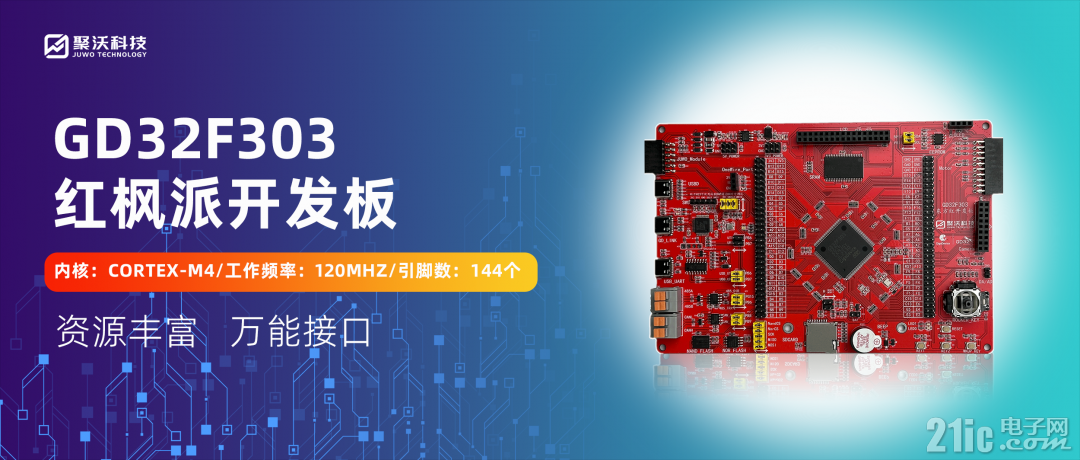
28.1 实验内容 通过本实验主要学习以下内容: • CDC虚拟串口协议原理及使用 • CDC虚拟串口通信操作 28.2 实验原理 USB的CDC类是USB通信设备类 (Communication Device Class)的简称。CDC类是USB组织定义的一类专门给各种通信设备使用的USB子类。该设备类采用批量传输。 本例程中实现了CDC设备类的相关请求,包括SET_LINE_CODING、GET_LINE_CODING、SET_CONTROL_LINE_STATE等。后续将会在代码解析章节进行介绍。 有关CDC协议可以通过以下USB官网下载或者通过红枫派开发板配套资料获取。 大家可以在学习的过程中结合历程代码和协议进行理解。 28.3 硬件设计 USB虚拟键盘实验章节已介绍。 28.4 代码解析 本例程主要实现USB虚拟串口的效果,在PC端可以通过串口调试助手或者设备管理器查到虚拟串口设备,并可实现通过该虚拟串口进行通信的现象。 本例程主函数如下,该函数架构与虚拟键盘例程相似,当USBD设备初始化且枚举完成后,USB设备首先通过cdc_acm_check_ready()函数check是否准备数据发送,如果不需要发送就调用cdc_acm_data_receive()函数接收上位机发送的数据,如果需要发送就调用cdc_acm_data_send()将接收到的数据发送给主机,主机再回显到串口调试助手的接收显示界面中。 - C
- int main(void)
- {
- /* system clocks configuration */
- rcu_config();
- /* GPIO configuration */
- gpio_config();
- /* USB device configuration */
- usbd_init(&usbd_cdc, &cdc_desc, &cdc_class);
- /* NVIC configuration */
- nvic_config();
- /* enabled USB pull-up */
- usbd_connect(&usbd_cdc);
- while (USBD_CONFIGURED != usbd_cdc.cur_status) {
- /* wait for standard USB enumeration is finished */
- }
- while (1) {
- if (0U == cdc_acm_check_ready(&usbd_cdc)) {
- cdc_acm_data_receive(&usbd_cdc);
- } else {
- cdc_acm_data_send(&usbd_cdc);
- }
- }
- }
下面为大家介绍下虚拟串口设备所使用的设备及配置描述符。 设备描述符如下所示,其中bDevcieClass为0x02,表明当前设备为CDC设备类。 - C
- usb_desc_dev cdc_dev_desc =
- {
- .header =
- {
- .bLength = USB_DEV_DESC_LEN,
- .bDescriptorType = USB_DESCTYPE_DEV,
- },
- .bcdUSB = 0x0200U,
- .bDeviceClass = USB_CLASS_CDC,
- .bDeviceSubClass = 0x00U,
- .bDeviceProtocol = 0x00U,
- .bMaxPacketSize0 = USBD_EP0_MAX_SIZE,
- .idVendor = USBD_VID,
- .idProduct = USBD_PID,
- .bcdDevice = 0x0100U,
- .iManufacturer = STR_IDX_MFC,
- .iProduct = STR_IDX_PRODUCT,
- .iSerialNumber = STR_IDX_SERIAL,
- .bNumberConfigurations = USBD_CFG_MAX_NUM,
- };
配置描述符如下所示,由配置描述符可知,该USB虚拟串口设备包含两个接口:CMD命令接口和data数据接口。CMD命令接口包含一个IN端点,用于传输命令,该端点采用中断传输方式,轮询间隔为10ms,最大包长为8字节。data数据接口包含一个OUT端点和一个IN端点,这两个端点均采用批量传输方式,最大包长为64字节。另外,该配置描述符中包含了一些类特殊接口描述符,具体请读者参阅CDC类标准协议。 - C
- usb_cdc_desc_config_set cdc_config_desc =
- {
- .config =
- {
- .header =
- {
- .bLength = sizeof(usb_desc_config),
- .bDescriptorType = USB_DESCTYPE_CONFIG,
- },
- .wTotalLength = USB_CDC_ACM_CONFIG_DESC_SIZE,
- .bNumInterfaces = 0x02U,
- .bConfigurationValue = 0x01U,
- .iConfiguration = 0x00U,
- .bmAttributes = 0x80U,
- .bMaxPower = 0x32U
- },
- .cmd_itf =
- {
- .header =
- {
- .bLength = sizeof(usb_desc_itf),
- .bDescriptorType = USB_DESCTYPE_ITF
- },
- .bInterfaceNumber = 0x00U,
- .bAlternateSetting = 0x00U,
- .bNumEndpoints = 0x01U,
- .bInterfaceClass = USB_CLASS_CDC,
- .bInterfaceSubClass = USB_CDC_SUBCLASS_ACM,
- .bInterfaceProtocol = USB_CDC_PROTOCOL_AT,
- .iInterface = 0x00U
- },
- .cdc_header =
- {
- .header =
- {
- .bLength = sizeof(usb_desc_header_func),
- .bDescriptorType = USB_DESCTYPE_CS_INTERFACE
- },
- .bDescriptorSubtype = 0x00U,
- .bcdCDC = 0x0110U
- },
- .cdc_call_managment =
- {
- .header =
- {
- .bLength = sizeof(usb_desc_call_managment_func),
- .bDescriptorType = USB_DESCTYPE_CS_INTERFACE
- },
- .bDescriptorSubtype = 0x01U,
- .bmCapabilities = 0x00U,
- .bDataInterface = 0x01U
- },
- .cdc_acm =
- {
- .header =
- {
- .bLength = sizeof(usb_desc_acm_func),
- .bDescriptorType = USB_DESCTYPE_CS_INTERFACE
- },
- .bDescriptorSubtype = 0x02U,
- .bmCapabilities = 0x02U,
- },
- .cdc_union =
- {
- .header =
- {
- .bLength = sizeof(usb_desc_union_func),
- .bDescriptorType = USB_DESCTYPE_CS_INTERFACE
- },
- .bDescriptorSubtype = 0x06U,
- .bMasterInterface = 0x00U,
- .bSlaveInterface0 = 0x01U,
- },
- .cdc_cmd_endpoint =
- {
- .header =
- {
- .bLength = sizeof(usb_desc_ep),
- .bDescriptorType = USB_DESCTYPE_EP,
- },
- .bEndpointAddress = CDC_CMD_EP,
- .bmAttributes = USB_EP_ATTR_INT,
- .wMaxPacketSize = CDC_ACM_CMD_PACKET_SIZE,
- .bInterval = 0x0AU
- },
- .cdc_data_interface =
- {
- .header =
- {
- .bLength = sizeof(usb_desc_itf),
- .bDescriptorType = USB_DESCTYPE_ITF,
- },
- .bInterfaceNumber = 0x01U,
- .bAlternateSetting = 0x00U,
- .bNumEndpoints = 0x02U,
- .bInterfaceClass = USB_CLASS_DATA,
- .bInterfaceSubClass = 0x00U,
- .bInterfaceProtocol = USB_CDC_PROTOCOL_NONE,
- .iInterface = 0x00U
- },
- .cdc_out_endpoint =
- {
- .header =
- {
- .bLength = sizeof(usb_desc_ep),
- .bDescriptorType = USB_DESCTYPE_EP,
- },
- .bEndpointAddress = CDC_OUT_EP,
- .bmAttributes = USB_EP_ATTR_BULK,
- .wMaxPacketSize = CDC_ACM_DATA_PACKET_SIZE,
- .bInterval = 0x00U
- },
- .cdc_in_endpoint =
- {
- .header =
- {
- .bLength = sizeof(usb_desc_ep),
- .bDescriptorType = USB_DESCTYPE_EP
- },
- .bEndpointAddress = CDC_IN_EP,
- .bmAttributes = USB_EP_ATTR_BULK,
- .wMaxPacketSize = CDC_ACM_DATA_PACKET_SIZE,
- .bInterval = 0x00U
- }
- };
为了实现CDC设备类,设备需要支持一些设备类专用请求,这些类专用请求的处理在cdc_acm_req_handler()函数中,该函数的定义如下所示,其中SET_LINE_CODING命令用于响应主机向设备发送设备配置,包括波特率、停止位、字符位数等,收到的数据保存在noti_bu内。GET_LINE_CODING命令用于主机请求设备当前的波特率、停止位、奇偶校验位和字符位数,但在本例程中,主机并未请求该命令,所以设备所设置的串口数据并没有作用,主机可以选择任意波特率与设备进行通信。其他的命令在本例程中并未进行处理,读者可以参考标准CDC类协议。 - C
- static uint8_t cdc_acm_req_handler (usb_dev *udev, usb_req *req)
- {
- uint8_t status = REQ_NOTSUPP, noti_buf[10] = {0U};
- usb_cdc_handler *cdc = (usb_cdc_handler *)udev->class_data[CDC_COM_INTERFACE];
- acm_notification *notif = (void *)noti_buf;
- switch (req->bRequest) {
- case SEND_ENCAPSULATED_COMMAND:
- break;
- case GET_ENCAPSULATED_RESPONSE:
- break;
- case SET_COMM_FEATURE:
- break;
- case GET_COMM_FEATURE:
- break;
- case CLEAR_COMM_FEATURE:
- break;
- case SET_LINE_CODING:
- /* set the value of the current command to be processed */
- udev->class_core->req_cmd = req->bRequest;
- usb_transc_config(&udev->transc_out[0U], (uint8_t *)&cdc->line_coding, req->wLength, 0U);
- status = REQ_SUPP;
- break;
- case GET_LINE_CODING:
- usb_transc_config(&udev->transc_in[0U], (uint8_t *)&cdc->line_coding, 7U, 0U);
- status = REQ_SUPP;
- break;
- case SET_CONTROL_LINE_STATE:
- notif->bmRequestType = 0xA1U;
- notif->bNotification = USB_CDC_NOTIFY_SERIAL_STATE;
- notif->wIndex = 0U;
- notif->wValue = 0U;
- notif->wLength = 2U;
- noti_buf[8] = (uint8_t)req->wValue & 3U;
- noti_buf[9] = 0U;
- status = REQ_SUPP;
- break;
- case SEND_BREAK:
- break;
- default:
- break;
- }
- return status;
- }
下面为大家介绍USBD虚拟串口设备数据的收发。 数据接收通过cdc_acm_data_receive()函数实现,该函数的程序如下所示。在该函数中,首先将packet_receive标志位设置为0,表明接下来将进行接收数据,当接收完成时,在cdc_acm_data_out()函数中,将packet_receive标志位置1,表明数据接收完成。usbd_ep_recev()用于配置接收操作,利用CDC_OUT_EP端点,将接收到的数据放置在cdc->data用户缓冲区中。 - C
- void cdc_acm_data_receive(usb_dev *udev)
- {
- usb_cdc_handler *cdc = (usb_cdc_handler *)udev->class_data[CDC_COM_INTERFACE];
- cdc->packet_receive = 0U;
- cdc->pre_packet_send = 0U;
- usbd_ep_recev(udev, CDC_OUT_EP, (uint8_t*)(cdc->data), USB_CDC_RX_LEN);
- }
- static void cdc_acm_data_out (usb_dev *udev, uint8_t ep_num)
- {
- usb_cdc_handler *cdc = (usb_cdc_handler *)udev->class_data[CDC_COM_INTERFACE];
- cdc->packet_receive = 1U;
- cdc->receive_length = udev->transc_out[ep_num].xfer_count;
- }
数据发送通过cdc_acm_data_send()函数实现,该函数的程序如下所示。在该函数中,首先将packet_sent标志位设置为0,表明接下来将进行发送数据,当数据发送完成时,在cdc_acm_data_in()函数中,将packet_sent标志位设置为1,表明数据发送完成。usbd_ep_send()用于配置发送操作,利用CDC_IN_EP端点,将以cdc->data地址为起始data_len长度的数据发送给主机。 - C
- void cdc_acm_data_send (usb_dev *udev)
- {
- usb_cdc_handler *cdc = (usb_cdc_handler *)udev->class_data[CDC_COM_INTERFACE];
- uint32_t data_len = cdc->receive_length;
- if ((0U != data_len) && (1U == cdc->packet_sent)) {
- cdc->packet_sent = 0U;
- usbd_ep_send(udev, CDC_IN_EP, (uint8_t*)(cdc->data), (uint16_t)data_len);
- cdc->receive_length = 0U;
- }
- }
- static void cdc_acm_data_in (usb_dev *udev, uint8_t ep_num)
- {
- usb_transc *transc = &udev->transc_in[ep_num];
- usb_cdc_handler *cdc = (usb_cdc_handler *)udev->class_data[CDC_COM_INTERFACE];
- if (transc->xfer_count == transc->max_len) {
- usbd_ep_send(udev, EP_ID(ep_num), NULL, 0U);
- } else {
- cdc->packet_sent = 1U;
- cdc->pre_packet_send = 1U;
- }
- }
28.5 实验结果 将本例程烧录到红枫派开发板中,并通过TypeC数据线连接USB通信接口和PC,在WIN7上虚拟串口需要安装驱动,在WIN8 WIN10以及后续版本的系统上不需要安装驱动。 下面介绍WIN7系统的驱动安装过程。 在WIN7系统上,将Tyep C数据线连接到PC后,将会在设备管理器中发现一个未知设备,通过以下连接可以下载官方提供的虚拟串口驱动:https://www.gd32mcu.com/download/down/document_id/44/path_type/1 下载驱动并进行安装,之后将会在设备管理器中发现虚拟串口设备已经识别。 之后即可通过串口调试助手与MCU进行CDC通信,在串口调试助手中打开对应虚拟串口的端口,然后输入任意字符,进行发送,将会在接收窗口中看到MCU返回的接收数据,具体现象如下所示。 本教程由GD32 MCU方案商聚沃科技原创发布,了解更多GD32 MCU教程,关注聚沃科技官网,GD32MCU技术交流群:859440462
|